[javascript protected email address]
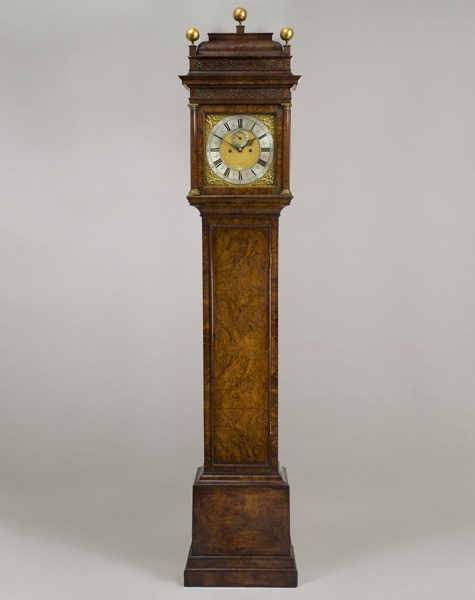
Richard Street, London

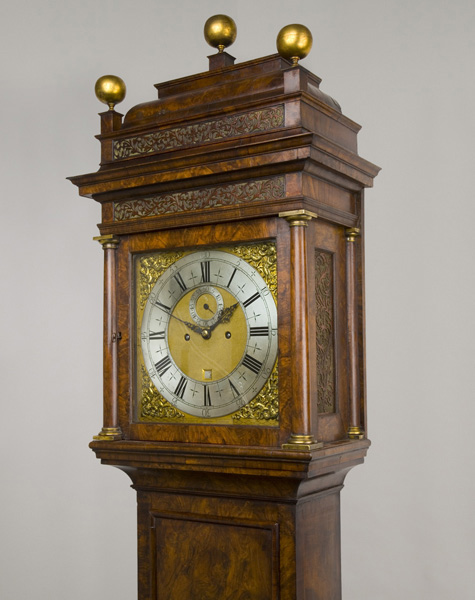
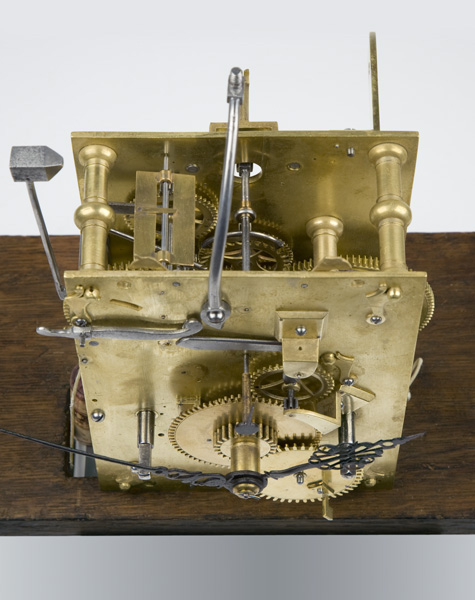
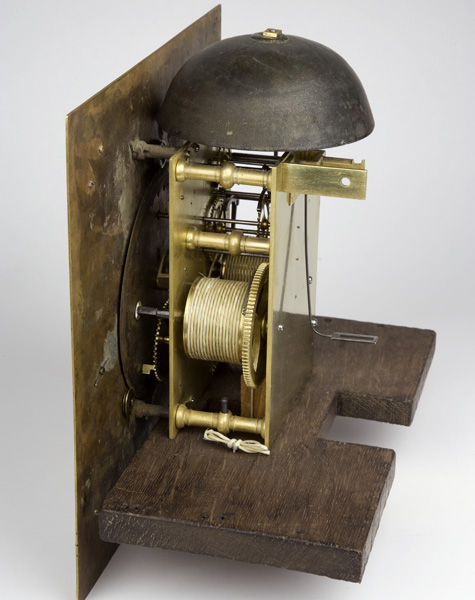
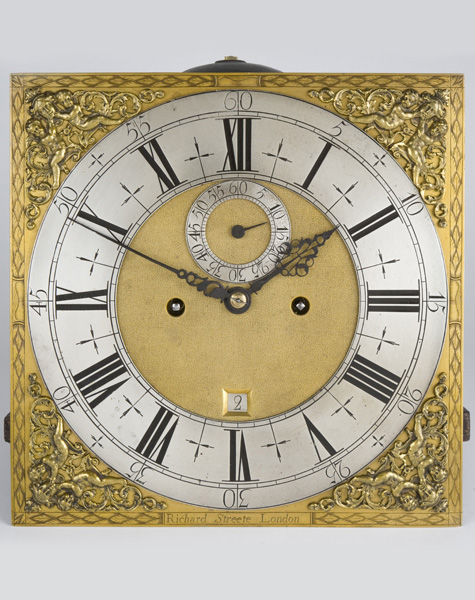
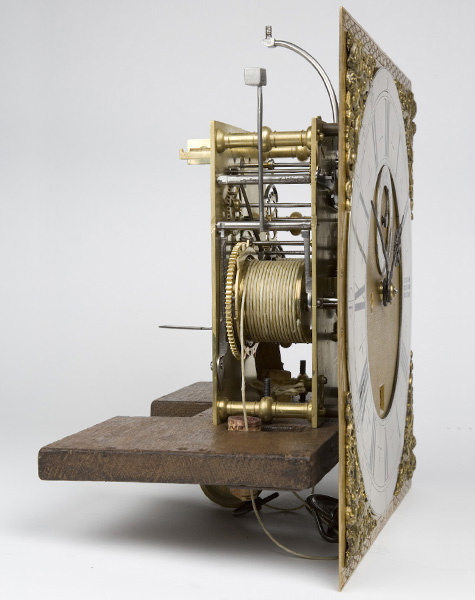
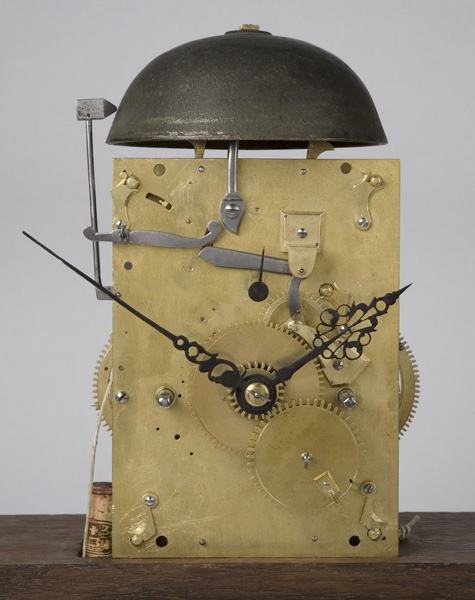
Circa 1710
Sold
8 feet high
A particularly fine George I walnut 8-day longcase clock. CASE The hood is surmounted by a moulded caddy top with three cast brass ball finials on walnut pedestals; the frieze below is set to the front and sides with long rectangular pierced walnut sound frets, the door is flanked by brass-capped three quarter columns with similar quarter columns to the rear, beneath the hood door is a concave throat moulding and the rectangular trunk door which has D-end mouldings and is veneered with four panels of well figured walnut, each side of the trunk is veneered with twin walnut panels framed with herringbone line inlay. The plinth is similarly veneered with single panels of walnut framed with herringbone inlay and the whole case is raised on a double skirted footing with concave and D-end mouldings. DIAL The 12 inch brass dial is signed Richard Street London on a rectangular reserve at the base of the dial which is entirely framed by wheatear engraving, the unusual spandrels are double screwed and cast with twin cherubs supporting a classical female head with foliate diadem; the silvered brass chapter ring has Roman hour numerals with sword hilt half hour markers, similar sword hilt half quarter markers to the outer ring with Arabic five minute divisions. The centre of the dial is finely matted and has a silvered seconds ring, calendar aperture and finely pierced blued steel hour and minute hands. MOVEMENT Comprising two long thick brass movement plates secured by six ring-turned latched pillars, latches also to the four dial feet. The going train has anchor escapement with a particularly delicate steel anchor pivoting at the backplate on a chamfered brass backcock suspending the pendulum with steel rod and brass-faced bob. The strike train has an internal countwheel striking on a bell above the movement plates with manual trip lever to the left side to re-set the strike as necessary. The brass-cased weights are suspended on brass pulley and gut lines. RICHARD STREET, LONDON Richard Street was a most noteworthy clockmaker who seems to have escaped most collectors’ attentions, despite his blue-chip credentials. He is noted in Thomas Tompion at the Dial and Three Crowns by Jeremy Evans (Antiquarian Horology, 2006, p. 114), as “An outstanding clockmaker whose origins have not been ascertained. Made Free in 1687, he is believed to have worked in Fleet Street, and there is clear evidence that he was responsible for some of Tompion's repeating watch movements.” Richard Street(e) was noted principally as a watchmaker. Nothing is recorded about his apprenticeship but as mentioned above there is clear evidence that he must have spent at least some of his early formative years at Tompion’s workshops. He is recorded as being made Free of the Clockmakers’ Company in September 1687. However his contact with the Company was minimal, there is no record of his taking any apprentices but he was made an Assistant in 1713 and Warden in 1716, but was excused duties as he ‘had urgent business on his hands’. He was initially recorded as ‘probably’ working in Shoe Lane then in 1716 he was recorded as residing in Fleet Street when he was involved with William Wright in taking over the running of St. Paul’s clock from Langley Bradley. WORK KNOWN CLOCKS: The Octagon Room, Greenwich Observatory; astronomical longcase clock in panelled ebony case. Originally thought to have been designed to help make angular measurements to establish the position of a celestial body in the heavens. The minute hand rotates every 10 minutes each hour and thus doubles as a seconds hand if you can read the dial well enough. This clock is thought to have originally belonged to Sir Isaac Newton ‘The Black Clock on the staires’ mentioned in the inventory of Newton’s affects found after his death in his house in Jermyn Street. Trinity College, Cambridge observatory clock. Made in 1708 for the observatory above the college gates and presented to the college by Sir Isaac Newton. It shows the seconds in the arch – perhaps the first use of this feature. Ebony wall clock of two-month duration with ‘extending’ hour hand. Weight-driven wall clock with rounded triangular hour ring on the dial – the single hour hand operates on a cam wheel behind the dial, minute ring below. The dial is engraved with a rose and a thistle thought to commemorate the Act of Union in 1707 between the English and Scottish Parliaments. (Sotheby’s, Nine English Clocks, 28 May, 1982, lot 5, £22,000) Turret clock made for the stable block at Osterley Park House, punch signed and dated 1714. Queen Anne gilt-brass miniature ‘travelling’ timepiece, about 1710 in date. Breakarch case engraved on the sides and top, loop handle at top, signed Richd. Street on a blued steel plaque in the matted centre. 8 ½ inches high. There are a total of only eight longcase clocks recorded made by Street, including the two listed above. It is highly likely that Richard Street made certain watches for Thomas Tompion. There is currently no known documentary evidence to support their collaboration, although the physical evidence is compelling. Apart from the close locality of their workshops and the undoubted similarity of their work there are examples of Tompion’s watches that are scratch-signed RS. Furthermore, the only recorded example of a watch which uses Tompion’s watch repeat system, but not signed by him, is an example signed by Street. It is also interesting to note that Richard Street published an equation table that was virtually identical to one published by Tompion (The Longcase Clock by Tom Robinson, fig. 8/16) – the title and instructions, as well as the equation table are exactly the same. It seems highly unlikely that a man of Tompion’s standing and position in the horological world would have allowed such latitude unless there was already a certain working relationship between the two of them. Street was patently a very talented clock and watchmaker with an inquisitive scientific mind. Many of his clocks and watches have singularly unusual dials with scientific indications and strange lay-outs. The movements and cases are always of the very highest quality and are rarely alike. He also had some significant contacts in the scientific and aristocratic echelons of society, not least having made one or possibly two clocks for Sir Isaac Newton.
